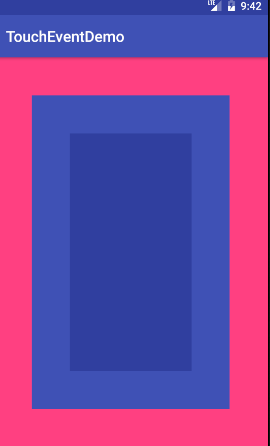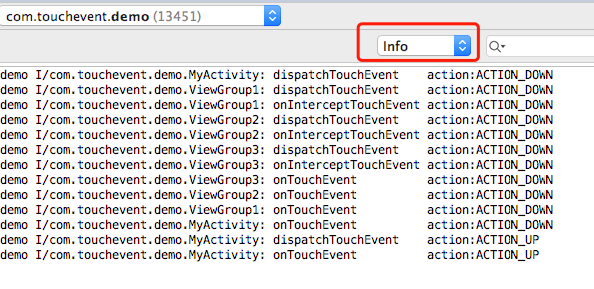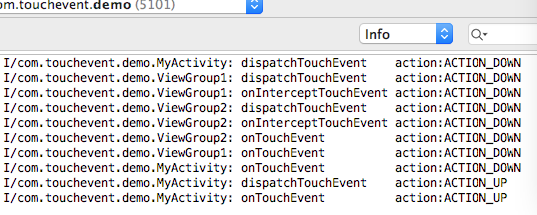什么是事件?事件是用户触摸手机屏幕,引起的一系列TouchEvent,包括ACTION_DOWN、ACTION_MOVE、ACTION_UP、ACTION_CANCEL等,这些action组合后变成点击事件、长按事件等。
在这篇文章中,用打Log测试的方法来了解Android TouchEvent 事件分发,拦截,处理过程。虽然看了一些其他的文章和源码及相关的资料,但是还是觉得需要打下Log和画图来了解一下,不然很容易忘记了事件传递的整个过程。所以写下这篇文章,达到看完这篇文章基本可以了解整个过程,并且可以自己画图画出来给别人看。
先看几个类,主要是画出一个3个ViewGroup叠加的界面,并在事件分发、拦截、处理时打下Log.

GitHub地址:https://github.com/libill/TouchEventDemo
一、通过打log分析事件分发
这里在一个Activity上添加三个ViewGroup来分析,这里值得注意的是Activity、View是没有onInterceptTouchEvent方法的。
一、了解Activity、ViewGroup1、ViewGroup2、ViewGroup3四个类
-
activity_main.xml
<?xml version="1.0" encoding="utf-8"?> <android.support.constraint.ConstraintLayout xmlns:android="http://schemas.android.com/apk/res/android" xmlns:app="http://schemas.android.com/apk/res-auto" xmlns:tools="http://schemas.android.com/tools" android:layout_width="match_parent" android:layout_height="match_parent" tools:context="com.touchevent.demo.MyActivity"> <com.touchevent.demo.ViewGroup1 android:layout_width="match_parent" android:layout_height="match_parent" android:background="@color/colorAccent"> <com.touchevent.demo.ViewGroup2 android:layout_width="match_parent" android:layout_height="match_parent" android:layout_margin="50dp" android:background="@color/colorPrimary"> <com.touchevent.demo.ViewGroup3 android:layout_width="match_parent" android:layout_height="match_parent" android:layout_margin="50dp" android:background="@color/colorPrimaryDark"> </com.touchevent.demo.ViewGroup3> </com.touchevent.demo.ViewGroup2> </com.touchevent.demo.ViewGroup1> </android.support.constraint.ConstraintLayout> -
主界面:MainActivity.java
public class MyActivity extends AppCompatActivity { private final static String TAG = MyActivity.class.getName(); @Override protected void onCreate(Bundle savedInstanceState) { super.onCreate(savedInstanceState); setContentView(R.layout.activity_main); } @Override public boolean dispatchTouchEvent(MotionEvent ev) { Log.i(TAG,"dispatchTouchEvent action:" + StringUtils.getMotionEventName(ev)); boolean superReturn = super.dispatchTouchEvent(ev); Log.d(TAG,"dispatchTouchEvent action:" + StringUtils.getMotionEventName(ev) + " " + superReturn); return superReturn; } @Override public boolean onTouchEvent(MotionEvent ev) { Log.i(TAG,"onTouchEvent action:" + StringUtils.getMotionEventName(ev)); boolean superReturn = super.onTouchEvent(ev); Log.d(TAG,"onTouchEvent action:" + StringUtils.getMotionEventName(ev) + " " + superReturn); return superReturn; } } -
三个ViewGroup,里面的代码完全一样:ViewGroup1.java,ViewGroup2.java,ViewGroup3.java。由于代码一样所以只贴其中一个类。
public class ViewGroup1 extends LinearLayout { private final static String TAG = ViewGroup1.class.getName(); public ViewGroup1(Context context) { super(context); } public ViewGroup1(Context context,AttributeSet attrs) { super(context,attrs); } @Override public boolean dispatchTouchEvent(MotionEvent ev) { Log.i(TAG,"dispatchTouchEvent action:" + StringUtils.getMotionEventName(ev) + " " + superReturn); return superReturn; } @Override public boolean onInterceptTouchEvent(MotionEvent ev) { Log.i(TAG,"onInterceptTouchEvent action:" + StringUtils.getMotionEventName(ev)); boolean superReturn = super.onInterceptTouchEvent(ev); Log.d(TAG,"onInterceptTouchEvent action:" + StringUtils.getMotionEventName(ev) + " " + superReturn); return superReturn; } @Override public boolean onTouchEvent(MotionEvent ev) { Log.i(TAG,"onTouchEvent action:" + StringUtils.getMotionEventName(ev) + " " + superReturn); return superReturn; } }
二、不拦截处理任何事件
添加没有拦截处理任何事件的代码,看看事件是怎么传递的,选择Info,查看Log.


从流程图可以看出,事件分发从Activity开始,然后分发到ViewGroup,在这个过程中,只要ViewGroup没有拦截处理,最后还是会回到Activity的onTouchEvent方法。
三、ViewGroup2的dispatchTouchEvent返回true
把ViewGroup2.java的dispatchTouchEvent修改一下,return 返回true使事件不在分发
@Override
public boolean dispatchTouchEvent(MotionEvent ev) {
Log.i(TAG,"dispatchTouchEvent action:" + StringUtils.getMotionEventName(ev));
Log.d(TAG,"onInterceptTouchEvent action:" + StringUtils.getMotionEventName(ev) + " " + true);
return true;
}
此时的Log


从图片可以看出,当ViewGroupon2的dispatchTouchEvent返回true后,事件不会再分发传送到ViewGroup3了,也不会分发到Activity的onTouchEvent了。而是事件到了ViewGroupon2的dispatchTouchEvent后,就停止了。dispatchTouchEvent返回true表示着事件不用再分发下去了。
四、ViewGroup2的onInterceptTouchEvent返回true
把ViewGroup2.java的onInterceptTouchEvent修改一下,return 返回true把事件拦截了
@Override
public boolean dispatchTouchEvent(MotionEvent ev) {
Log.i(TAG,"dispatchTouchEvent action:" + StringUtils.getMotionEventName(ev));
boolean superReturn = super.dispatchTouchEvent(ev);
Log.d(TAG,"dispatchTouchEvent action:" + StringUtils.getMotionEventName(ev) + " " + superReturn);
return superReturn;
}
@Override
public boolean onInterceptTouchEvent(MotionEvent ev) {
Log.i(TAG,"onInterceptTouchEvent action:" + StringUtils.getMotionEventName(ev));
Log.d(TAG,"onInterceptTouchEvent action:" + StringUtils.getMotionEventName(ev) + " " + true);
return true;
}
此时的Log


可以看出ViewGroup2拦截了事件,就不会继续分发到ViewGroup3;而且ViewGroup3拦截了事件又不处理事件,会把事件传递到Activity的onTouchEvent方法。
五、ViewGroup2的onInterceptTouchEvent、onTouchEvent返回true
把ViewGroup2.java的onTouchEvent修改一下,return 返回true把事件处理了
@Override
public boolean onInterceptTouchEvent(MotionEvent ev) {
Log.i(TAG,"onInterceptTouchEvent action:" + StringUtils.getMotionEventName(ev) + " " + true);
return true;
}
@Override
public boolean onTouchEvent(MotionEvent ev) {
Log.i(TAG,"onTouchEvent action:" + StringUtils.getMotionEventName(ev));
Log.d(TAG,"onTouchEvent action:" + StringUtils.getMotionEventName(ev) + " " + true);
return true;
}


从流程可以总结出,当ViewGroup2的onInterceptTouchEvent、onTouchEvent都返回true时,事件最终会走到ViewGroup2的onTouchEvent方法处理事件,后续的事件都会走到这里来。
上面通过log分析很清楚了,是不是就这样够了?其实还不行,还要从源码的角度去分析下,为什么事件会这样分发。
二、通过源码分析事件分发
一、Activity的dispatchTouchEvent
先看看Activity下的dispatchTouchEvent
public boolean dispatchTouchEvent(MotionEvent ev) {
if (ev.getAction() == MotionEvent.ACTION_DOWN) {
onUserInteraction();
}
if (getWindow().superDispatchTouchEvent(ev)) {
return true;
}
return onTouchEvent(ev);
}
onUserInteraction方法
public void onUserInteraction() {
}
从代码可以了解
-
调用Activity的onUserInteraction方法,action为down时会进去onUserInteraction方法,但是这个是空方法不做任何事情,可以忽略。
-
调用window的superDispatchTouchEvent方法,返回true时事件分发处理结束,否则会调用Activity的onTouchEvent方法。
-
调用Activity的onTouchEvent方法,进入这个条件的方法是window的superDispatchTouchEvent方法返回false。从上面的分析(二、不拦截处理任何事件)可以知道,所有子View的dispatchTouchEvent、onInterceptTouchEvent、onTouchEvent都返回false时会调动Activity的onTouchEvent方法,这个时候也是使window的superDispatchTouchEvent方法返回false成立。
二、window的superDispatchTouchEvent
Activity的getWindow方法
public Window getWindow() {
return mWindow;
}
mWindow是如何赋值的?
是在Activity的attach方法赋值的,其实mWindow是PhoneWindow。
Activity的attach方法
final void attach(Context context,ActivityThread aThread,Instrumentation instr,IBinder token,int ident,Application application,Intent intent,ActivityInfo info,CharSequence title,Activity parent,String id,NonConfigurationInstances lastNonConfigurationInstances,Configuration config,String referrer,IVoiceInteractor voiceInteractor,Window window,ActivityConfigCallback activityConfigCallback) {
attachBaseContext(context);
mFragments.attachHost(null /*parent*/);
mWindow = new PhoneWindow(this,window,activityConfigCallback);
mWindow.setWindowControllerCallback(this);
mWindow.setCallback(this);
mWindow.setOnWindowDismissedCallback(this);
mWindow.getLayoutInflater().setPrivateFactory(this);
...
}
PhoneWindow的superDispatchTouchEvent方法
private DecorView mDecor;
@Override
public boolean superDispatchTouchEvent(MotionEvent event) {
return mDecor.superDispatchTouchEvent(event);
}
DevorView的superDispatchTouchEvent
public boolean superDispatchTouchEvent(MotionEvent event) {
return super.dispatchTouchEvent(event);
}
而mDecor是一个继承FrameLayout的DecorView,就这样把事件分发到ViewGroup上了。
三、ViewGroup的dispatchTouchEvent
3.1 ViewGroup拦截事件的情况
// Check for interception.
final boolean intercepted;
if (actionMasked == MotionEvent.ACTION_DOWN
|| mFirstTouchTarget != null) {
final boolean disallowIntercept = (mGroupFlags & FLAG_DISALLOW_INTERCEPT) != 0;
if (!disallowIntercept) {
intercepted = onInterceptTouchEvent(ev);
ev.setAction(action); // restore action in case it was changed
} else {
intercepted = false;
}
} else {
// There are no touch targets and this action is not an initial down
// so this view group continues to intercept touches.
intercepted = true;
}
这里分为2种情况会判断是否需要拦截,也就是当某一条件成立时,会执行onInterceptTouchEvent判断是否需要拦截事件。
-
当actionMasked == MotionEvent.ACTION_DOWN时。
-
当mFirstTouchTarget != null时。mFirstTouchTarget是成功处理事件的ViewGroup的子View,也就是ViewGroup的子View在以下情况返回true时,这个在log分析流程图轻易得到:
2.1 dispatchTouchEvent返回true
2.2 如果子View是ViewGroup时,onInterceptTouchEvent、onTouchEvent返回true
另外还有一种情况是disallowIntercept为true时,intercepted直接赋值false不进行拦截。FLAG_DISALLOW_INTERCEPT是通过requestDisallowInterceptTouchEvent方法来设置的,用于在子View中设置,设置后ViewGroup只能拦截down事件,无法拦截其他move、up、cancel事件。为什么ViewGroup还能拦截down事件呢?因为ViewGroup在down事件时进行了重置,看看以下代码
// Handle an initial down.
if (actionMasked == MotionEvent.ACTION_DOWN) {
// Throw away all previous state when starting a new touch gesture.
// The framework may have dropped the up or cancel event for the previous gesture
// due to an app switch,ANR,or some other state change.
cancelAndClearTouchTargets(ev);
resetTouchState();
}
private void resetTouchState() {
clearTouchTargets();
resetCancelNextUpFlag(this);
mGroupFlags &= ~FLAG_DISALLOW_INTERCEPT;
mNestedScrollAxes = SCROLL_AXIS_NONE;
}
通过源码可以了解到,ViewGroup拦截事件后,不再调用onInterceptTouchEvent,而是直接交给mFirstTouchTarget的onTouchEvent处理,如果该onTouchEvent不处理最终会交给Activity的onTouchEvent。
3.2 ViewGroup不拦截事件的情况
ViewGroup不拦截事件时,会遍历子View,使事件分发到子View进行处理。
final View[] children = mChildren;
for (int i = childrenCount - 1; i >= 0; i--) {
final int childIndex = getAndVerifyPreorderedIndex(
childrenCount,i,customOrder);
final View child = getAndVerifyPreorderedView(
preorderedList,children,childIndex);
// If there is a view that has accessibility focus we want it
// to get the event first and if not handled we will perform a
// normal dispatch. We may do a double iteration but this is
// safer given the timeframe.
if (childWithAccessibilityFocus != null) {
if (childWithAccessibilityFocus != child) {
continue;
}
childWithAccessibilityFocus = null;
i = childrenCount - 1;
}
if (!canViewReceivePointerEvents(child)
|| !isTransformedTouchPointInView(x,y,child,null)) {
ev.setTargetAccessibilityFocus(false);
continue;
}
newTouchTarget = getTouchTarget(child);
if (newTouchTarget != null) {
// Child is already receiving touch within its bounds.
// Give it the new pointer in addition to the ones it is handling.
newTouchTarget.pointerIdBits |= idBitsToAssign;
break;
}
resetCancelNextUpFlag(child);
if (dispatchTransformedTouchEvent(ev,false,idBitsToAssign)) {
// Child wants to receive touch within its bounds.
mLastTouchDownTime = ev.getDownTime();
if (preorderedList != null) {
// childIndex points into presorted list,find original index
for (int j = 0; j < childrenCount; j++) {
if (children[childIndex] == mChildren[j]) {
mLastTouchDownIndex = j;
break;
}
}
} else {
mLastTouchDownIndex = childIndex;
}
mLastTouchDownX = ev.getX();
mLastTouchDownY = ev.getY();
newTouchTarget = addTouchTarget(child,idBitsToAssign);
alreadyDispatchedToNewTouchTarget = true;
break;
}
}
3.2.1 寻找可接收事件的子View
通过canViewReceivePointerEvents判断子View是否能够接收到点击事件。必须符合2种情况,缺一不可:1、点击事件的坐标落在在子View的区域内;2、子View没有正在播放动画。满足条件后,调用dispatchTransformedTouchEvent,其实也是调用子View的dispatchTouchEvent。
private static boolean canViewReceivePointerEvents(@NonNull View child) {
return (child.mViewFlags & VISIBILITY_MASK) == VISIBLE
|| child.getAnimation() != null;
}
protected boolean isTransformedTouchPointInView(float x,float y,View child,PointF outLocalPoint) {
final float[] point = getTempPoint();
point[0] = x;
point[1] = y;
transformPointToViewLocal(point,child);
final boolean isInView = child.pointInView(point[0],point[1]);
if (isInView && outLocalPoint != null) {
outLocalPoint.set(point[0],point[1]);
}
return isInView;
}
private boolean dispatchTransformedTouchEvent(MotionEvent event,boolean cancel,int desiredPointerIdBits) {
final boolean handled;
final int oldAction = event.getAction();
if (cancel || oldAction == MotionEvent.ACTION_CANCEL) {
event.setAction(MotionEvent.ACTION_CANCEL);
if (child == null) {
handled = super.dispatchTouchEvent(event);
} else {
handled = child.dispatchTouchEvent(event);
}
event.setAction(oldAction);
return handled;
}
...
// Perform any necessary transformations and dispatch.
if (child == null) {
handled = super.dispatchTouchEvent(transformedEvent);
} else {
final float offsetX = mScrollX - child.mLeft;
final float offsetY = mScrollY - child.mTop;
transformedEvent.offsetLocation(offsetX,offsetY);
if (! child.hasIdentityMatrix()) {
transformedEvent.transform(child.getInverseMatrix());
}
handled = child.dispatchTouchEvent(transformedEvent);
}
// Done.
transformedEvent.recycle();
return handled;
}
当dispatchTransformedTouchEvent返回true时,结束for循环遍历,赋值newTouchTarget,相当于发现了可以接收事件的View,不用再继续找了。
newTouchTarget = addTouchTarget(child,idBitsToAssign);
alreadyDispatchedToNewTouchTarget = true;
break;
在addTouchTarget方法赋值mFirstTouchTarget。
private TouchTarget addTouchTarget(@NonNull View child,int pointerIdBits) {
final TouchTarget target = TouchTarget.obtain(child,pointerIdBits);
target.next = mFirstTouchTarget;
mFirstTouchTarget = target;
return target;
}
3.2.2 ViewGroup自己处理事件
另一种情况是mFirstTouchTarget为空时,ViewGroup自己处理事件,这里注意第三个参数为null,ViewGroup的super.dispatchTouchEvent将调用View的dispatchTouchEvent。
if (mFirstTouchTarget == null) {
// No touch targets so treat this as an ordinary view.
handled = dispatchTransformedTouchEvent(ev,canceled,null,TouchTarget.ALL_POINTER_IDS);
}
3.3 View处理点击事件的过程
View的dispatchTouchEvent是怎么处理事件的呢?
public boolean dispatchTouchEvent(MotionEvent event) {
boolean result = false;
...
if (onFilterTouchEventForSecurity(event)) {
if ((mViewFlags & ENABLED_MASK) == ENABLED && handleScrollBarDragging(event)) {
result = true;
}
//noinspection SimplifiableIfStatement
ListenerInfo li = mListenerInfo;
if (li != null && li.mOnTouchListener != null
&& (mViewFlags & ENABLED_MASK) == ENABLED
&& li.mOnTouchListener.onTouch(this,event)) {
result = true;
}
if (!result && onTouchEvent(event)) {
result = true;
}
}
...
return result;
}
-
首先使用onFilterTouchEventForSecurity方法过滤不符合应用安全策略的触摸事件。
public boolean onFilterTouchEventForSecurity(MotionEvent event) { //noinspection RedundantIfStatement if ((mViewFlags & FILTER_TOUCHES_WHEN_OBSCURED) != 0 && (event.getFlags() & MotionEvent.FLAG_WINDOW_IS_OBSCURED) != 0) { // Window is obscured,drop this touch. return false; } return true; } -
mOnTouchListener != null判断是否设置了OnTouchEvent,设置了就执行mOnTouchListener.onTouch并返回true,不再执行onTouchEvent。这里得出OnTouchEvent的优先级高于OnTouchEvent,便于使用setOnTouchListener设置处理点击事件。
-
另一种情况是进入onTouchEvent进行处理。
public boolean onTouchEvent(MotionEvent event) { final float x = event.getX(); final float y = event.getY(); final int viewFlags = mViewFlags; final int action = event.getAction(); final boolean clickable = ((viewFlags & CLICKABLE) == CLICKABLE || (viewFlags & LONG_CLICKABLE) == LONG_CLICKABLE) || (viewFlags & CONTEXT_CLICKABLE) == CONTEXT_CLICKABLE; if ((viewFlags & ENABLED_MASK) == DISABLED) { if (action == MotionEvent.ACTION_UP && (mPrivateFlags & PFLAG_PRESSED) != 0) { setPressed(false); } mPrivateFlags3 &= ~PFLAG3_FINGER_DOWN; // A disabled view that is clickable still consumes the touch // events,it just doesn't respond to them. return clickable; } ... }
当View不可用时,依然会处理事件,只是看起来不可用。
接着执行mTouchDelegate.onTouchEvent
if (mTouchDelegate != null) {
if (mTouchDelegate.onTouchEvent(event)) {
return true;
}
}
下面看看up事件是怎么处理的
/**
* <p>Indicates this view can display a tooltip on hover or long press.</p>
* {@hide}
*/
static final int TOOLTIP = 0x40000000;
if (clickable || (viewFlags & TOOLTIP) == TOOLTIP) {
switch (action) {
case MotionEvent.ACTION_UP:
mPrivateFlags3 &= ~PFLAG3_FINGER_DOWN;
if ((viewFlags & TOOLTIP) == TOOLTIP) {
handleTooltipUp();
}
if (!clickable) {
removeTapCallback();
removeLongPressCallback();
mInContextButtonPress = false;
mHasPerformedLongPress = false;
mIgnoreNextUpEvent = false;
break;
}
boolean prepressed = (mPrivateFlags & PFLAG_PREPRESSED) != 0;
if ((mPrivateFlags & PFLAG_PRESSED) != 0 || prepressed) {
// take focus if we don't have it already and we should in
// touch mode.
boolean focusTaken = false;
if (isFocusable() && isFocusableInTouchMode() && !isFocused()) {
focusTaken = requestFocus();
}
if (prepressed) {
// The button is being released before we actually
// showed it as pressed. Make it show the pressed
// state now (before scheduling the click) to ensure
// the user sees it.
setPressed(true,x,y);
}
if (!mHasPerformedLongPress && !mIgnoreNextUpEvent) {
// This is a tap,so remove the longpress check
removeLongPressCallback();
// Only perform take click actions if we were in the pressed state
if (!focusTaken) {
// Use a Runnable and post this rather than calling
// performClick directly. This lets other visual state
// of the view update before click actions start.
if (mPerformClick == null) {
mPerformClick = new PerformClick();
}
if (!post(mPerformClick)) {
performClickInternal();
}
}
}
if (mUnsetPressedState == null) {
mUnsetPressedState = new UnsetPressedState();
}
if (prepressed) {
postDelayed(mUnsetPressedState,ViewConfiguration.getPressedStateDuration());
} else if (!post(mUnsetPressedState)) {
// If the post failed,unpress right now
mUnsetPressedState.run();
}
removeTapCallback();
}
mIgnoreNextUpEvent = false;
break;
...
}
return true;
}
从上面代码可以了解,clickable、TOOLTIP(长按)有一个为true时,就会消耗事件,使onTouchEvent返回true。其中PerformClick内部调用了performClick方法。
public boolean performClick() {
// We still need to call this method to handle the cases where performClick() was called
// externally,instead of through performClickInternal()
notifyAutofillManagerOnClick();
final boolean result;
final ListenerInfo li = mListenerInfo;
if (li != null && li.mOnClickListener != null) {
playSoundEffect(SoundEffectConstants.CLICK);
li.mOnClickListener.onClick(this);
result = true;
} else {
result = false;
}
sendAccessibilityEvent(AccessibilityEvent.TYPE_VIEW_CLICKED);
notifyEnterOrExitForAutoFillIfNeeded(true);
return result;
}
如果View设置了OnClickListener,那performClick会调用内部的onClick方法。
public void setOnClickListener(@Nullable OnClickListener l) {
if (!isClickable()) {
setClickable(true);
}
getListenerInfo().mOnClickListener = l;
}
public void setOnLongClickListener(@Nullable OnLongClickListener l) {
if (!isLongClickable()) {
setLongClickable(true);
}
getListenerInfo().mOnLongClickListener = l;
}
通过setOnClickListener设置clickable,通过setOnLongClickListener设置LONG_CLICKABLE长按事件。设置后使得onTouchEvent返回true。到这里我们已经分析完成点击事件的分发过程了。
本文地址:http://libill.github.io/2019/09/09/android-touch-event/
本文参考以下内容:
1、《Android开发艺术探索》
